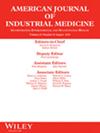Association Between Perfluoroalkyl Substance (PFAS) Exposure and Nonalcoholic Fatty Liver Disease in Korean Adults: Results From the KoNEHS 2018–2020: A Cross-Sectional Study
Abstract
Objectives
Nonalcoholic fatty liver disease (NAFLD) is a major public health problem and the most common chronic liver disease today. In Korea, the prevalence and incidence of NAFLD are currently very high, causing a serious social burden. Perfluoroalkyl substances (PFAS) have been consistently implicated as a potential cause of NAFLD, but research in Koreans is limited.
Methods
Using data from the 4th Korean National Environmental Health Survey (KoNEHS, n = 2792), we investigated the association between PFAS blood levels and NAFLD. Multivariable logistic regression models were used to calculate odds ratios (ORs) for the effects of PFAS. A mediation analysis was also conducted to examine the mediating effect of obesity. Finally, weighted quantile sum (WQS) and G-computation methods were implemented to evaluate the joint effect of PFAS mixtures. Hepatic steatosis index was used as a diagnostic tool for NAFLD. [Correction added on 15 May 2025, after first online publication: The KoNEHS n value was changed from 2859 to 2792 in this version.]
Results
Through multivariable logistic regression, statistically significant associations with NAFLD were observed for perfluorooctanoic acid (PFOA) (OR 1.09–1.39), perfluorooctansulfonate (PFOS) (1.09–1.40), perfluorohexanesulfonic acid (PFHxS) (1.04–1.22), perfluorononanoic acid (PFNA) (1.12–1.42), and total PFAS (1.21–1.81). We also found that obesity was a significant mediator for PFOA, PFNA, and total PFAS. The ORs for NAFLD obtained by WQS and G-computation methods in the multivariable adjusted model were 1.10–1.46 and 1.08–1.32, respectively.
Conclusions
This study confirmed a significant association between some PFAS and increased odds of NAFLD. Excessive exposure to PFAS might explain the high prevalence and incidence of chronic liver disease in Koreans. Long-term cohort studies are needed to assess geographic and occupational exposures in the Korean population.

 求助内容:
求助内容: 应助结果提醒方式:
应助结果提醒方式:


